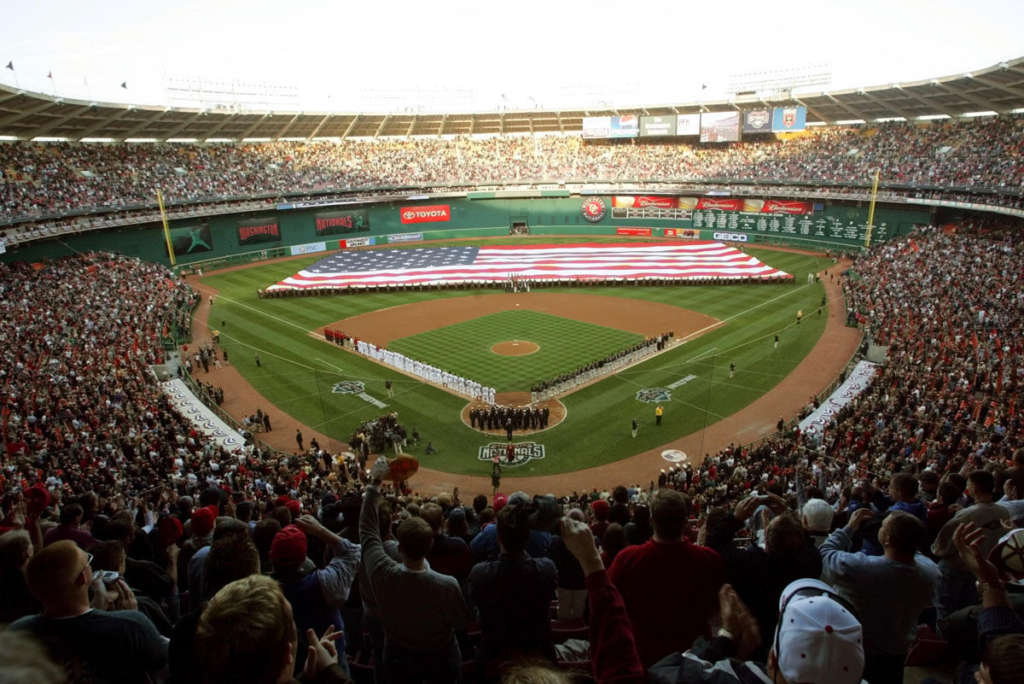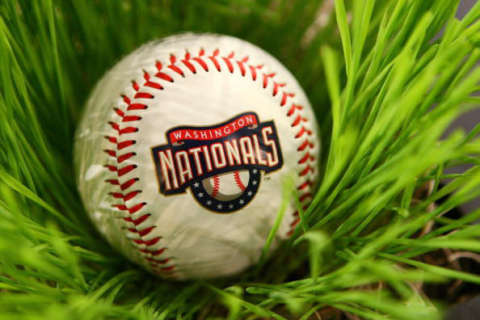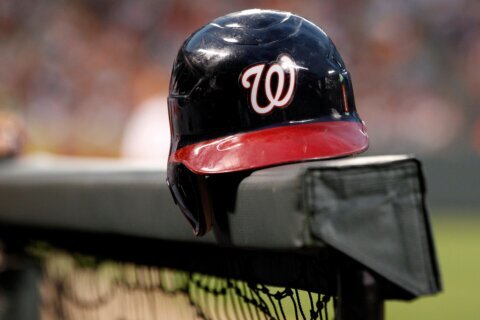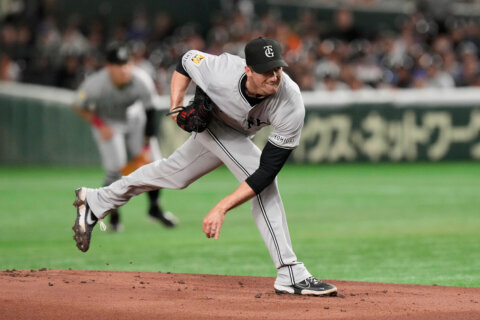
It’s hard to blame some Nationals fans for taking the whole thing for granted. They have been spoiled for much of the last decade by a perennial World Series contender led by headliners Max Scherzer, Stephen Strasburg, Juan Soto and the since-departed Bryce Harper and Anthony Rendon.
Washington has become a desired destination for free agents. The team is responsible for several grassroots baseball programs thanks to the Nationals Youth Baseball Academy. D.C. hosted one of baseball’s marquee events with the 2018 All-Star Game. There was also a parade down Constitution Avenue in 2019.
For modern-day Nationals fans, this is normal. In some cases, it may be all they know.
But in 2005, much of this would have seemed like a pipe dream. Back then, just having a major league team to call their own was a victory for Washingtonians. The District had gone more than three decades without one.
On Sept. 29, 2004, Major League Baseball announced that the Montreal Expos were moving to D.C. In November, they were formally introduced as the Nationals during a rush hour press conference in Union Station.
Fifteen years ago this week, Major League Baseball officially returned to D.C., when the Nationals hosted the Arizona Diamondbacks in their home opener at RFK Stadium.
It was Washington’s first home opener since 1971. It was also the culmination of a tumultuous three years for the core of the team, which had been operating without an owner since 2002 and had split home games the previous two seasons between Montreal and San Juan.
Below are some memories and audio clips from those associated with the 2005 Nationals who experienced the move and were part of the home opener on April 14, 2005.
JOHN DEVER (SENIOR DIRECTOR OF BASEBALL INFORMATION): You’ve got to start with D-Day, unfortunately, in Montreal and how hard and fast and real that all was. It was the day before the final home game in Montreal when the news came in. It was incredibly emotional. I’m a baseball lifer, and to see a city and its ballclub put to bed like that was tough. It was heart wrenching.
BRIAN SCHNEIDER (CATCHER): There were a lot of unknowns. We were leaving a city in Montreal that had given a lot of us a chance to start our big league careers. It had such a storied history, so that was tough. But we had to start to look forward. We knew Washington was excited, so we were talking a lot that offseason, but we really had no idea what to expect.
CHAD CORDERO (CLOSER): It was a weird situation for me because I had played in Montreal for just over a year, but I had just started to settle in. I loved the city. The city is beautiful. So it was sad because that last game in Montreal, you saw all the heartbreak from the fans. People were crying. But at the same time, it was an exciting time for us that offseason.
JAMEY CARROLL (INFIELDER): The thing that led to the excitement is we knew where we were going. The last few years in Montreal, you just never knew what the situation was going to be. So, MLB finally making a decision and giving us a home caused some excitement because we knew there was going to be a next year.
While players looked forward to a fresh start, a bare-bones office and sales staff was assembled in Washington. The staff primarily worked out of trailers outside RFK Stadium in the months leading up to the season opener. A handful of employees spent the winter at the team’s spring training home in Florida.
JIM BOWDEN (GENERAL MANAGER): It was quite the challenge. We didn’t have offices. When I got there, the organization had been completely stripped of scouts and player development [personnel]. It was right down to the bare bones, because it was being sold. It was extremely challenging.
DEVER: We were on conference calls all the time. It was difficult to picture it all coming together. The few employees that [team president] Tony Tavares and [executive VP] Kevin Uhlich were able to secure, none of them, or precious few of them, had any baseball experience.
BOWDEN: One of the rules that we had was that we couldn’t hire any new positions — we could only hire people to replace people.
CHARLIE SLOWES (PLAY-BY-PLAY BROADCASTER): A few weeks before the season, I was hired over the phone without even meeting anybody. A crazy scenario! So, in mid-March, I drove up to D.C. to find a place to live and I stopped by RFK. They were operating out of trailers while the offices were being remodeled. The press box was being rebuilt. They had removed all of the stands on the first and third base sides to install the batting cage tunnels under the stands. So, when I saw RFK two weeks before the exhibition game, I thought, “There’s no way we’re going to have a game here in two weeks!”
On April 3, 2005, the Nationals hosted the New York Mets in an exhibition game at RFK Stadium. It was widely viewed as a dress rehearsal for the home opener 11 days later. Upon arrival, the Mets got off the team bus with their equipment bags only to be denied entry by stadium security guards.
DEVER: That day was a debacle.
CORDERO: We didn’t know how RFK was going to be. We figured it was going to be a step up from Olympic Stadium [in Montreal], but I remember that exhibition game against the Mets, it felt like mid-20s with the wind chill and then there was no hot water after the game. We were like, “Oh, maybe we didn’t step into a better stadium situation.”
BOWDEN: On the one hand, there was history at RFK. There was the chair of Frank Howard’s upper-deck home run. But at the same time, there was the smell of sewer.
SLOWES: The Nationals were in a terrible clubhouse. They were in the old visiting football locker room. D.C. United had the big old Redskins locker room because they were the team already housed in the stadium. The Nationals got the other room.
DEVER: That morning, I couldn’t even put out lineups — the most basic function that they were probably doing 100 years ago — because I couldn’t find a working copier. I couldn’t find a copier that wasn’t broken. I couldn’t do my most basic function as a PR person. So it was a learning experience. Fortunately, I don’t think anybody up in the press box cared a lick. All they cared about were the guys on the field and that they weren’t going away any time soon.
The Nationals opened the season with a three-city, nine-game road trip and returned home with a winning record. The season-opening trip allowed the stadium grounds crew to put the finishing touches on a revamped RFK. Tremendous anticipation was building in D.C. in the hours leading up to the home opener and the pomp and circumstance surrounding it.
SLOWES: People were excited just to have baseball, but now they were excited about a team that was playing well. I think people jumped right onto the wagon from Day One.
BOWDEN: It was a surreal feeling. I remember going on Chris Matthews’ “Hardball” show that morning. Everybody was there. It wasn’t just Opening Day. It wasn’t just a sporting event. It was a national event. It was a news event. All the news people were there. It wasn’t just sports. I had been through really special Opening Days in Cincinnati, because Cincinnati used to be the franchise that opened up every season. So I was used to great Opening Days, but this was a whole other level.
SLOWES: I wanted to be there when the gates opened and people came in. That’s a tremendous memory for me. People came running in, streaming in, kids, parents, you could see grandparents, and maybe a lot of folks who were at that last game in 1971. When people came into the ballpark, they entered at the top of the lower bowl and they just kind of streaked to the railings looking down onto the field to see the Nationals taking batting practice. The smiles, the looks on people’s faces. Some of the older folks had tears streaming down their faces, because to them, RFK Stadium looked almost identical to how it looked when the Senators last played there back in 1971.
CORDERO: You could feel the buzz. There was a real buzz about baseball being back in D.C. So when I walked into the stadium it was like, ‘Wow this is really happening.’ And With President [George W.] Bush coming that night, we had to go through all this security with the metal detectors and bomb-sniffing dogs. You had the snipers up on the roof. We had a Secret Service guy in a uniform in the dugout. It was surreal. It was the first game back, and we had the president throwing out the first pitch. It was a whole lot of new things that I had never experienced before in my life. I was excited just to be a part of it.
DEVER: We had President Bush meet the team, and I will always appreciate him doing that, because it lent us a little dose of legitimacy that I think everybody needed — everybody that had been working towards baseball in Washington, D.C. To have the president show up on Opening Day, spend time with the ballclub in the clubhouse before the game — and we were only a few years post 9/11 — that was special.
SLOWES: He was a huge baseball fan, a former owner of the Texas Rangers. We were told he used to listen to games on Air Force One when he traveled to pass some of the time. All throughout that year, he’d invite players to the White House for coffee or lunch.
BOWDEN: He loved to talk baseball. I remember that first year talking trades with him. One of the trades that I made when I was GM in those early years, I traded Brad Wilkerson [to Texas] for Alfonso Soriano. Well, before I made that deal, I was talking to him about possibly trading Brad Wilkerson for Vernon Wells of Toronto. And so, the whole discussion of trading Brad Wilkerson I actually had with the president of the United States. I got his input on the trade, so we ended up eventually doing Wilkerson for Soriano. But what GM gets to have the president of the United States come to his box and talk trades with?
SCHNEIDER: Before the game, the Secret Service was telling us what we can do, what we can’t do, where to stand. We didn’t know how formal or how relaxed it was going to be. But President Bush is a great baseball guy, and he made you feel like he was just another guy. It was a great time.
When he met [starting pitcher] Tomo Ohka, he said a few things in Japanese. When he met the Spanish-speaking guys, he spoke Spanish to them. Very nonchalant, nothing formal. Just made everyone feel comfortable. [Reliever] Joey Eischen was very formal, very “Hi, Mr. President. Very nice to meet you. It’s a pleasure.” And then Bush is like: “Joey Eischen? When I was with the Rangers we traded you!” And he gave the date or the year and said, “We traded you for Oil Can Boyd.”
And then Joey Eischen was just at a loss for words. He was like: “I can’t believe you remember that. You know my name?” And Bush said, “Yeah, I remember you, Joey.” Joey was in shock. [Bush] was the president, but he just made everyone feel relaxed. One of the best things I’ve ever experienced — seeing him interact with us and making everyone feel at ease.
SLOWES: The guy who got to spend the most time with him was Schneider. The president wanted to play catch and really warm up … under stands before the first pitch. So they got to talk and take pictures.
SCHNEIDER: Shoot, it was a good 15 to 20 minutes. He just wanted to loosen up his arm. He had the [bullet-proof] vest and jacket on, so he wanted to get used to throwing with that. He’d throw a couple pitches and then ask me where I’m from. I’d answer, he’d throw a couple more pitches, and we’d talk some more. We just had a nonchalant, great conversation going back and forth about where my family was from. I told him my dad went to the Naval Academy; he thanked him for his service.
CARROLL: I still, to this day, love to pick on Brian Schneider because for the years prior to that, I was always the guy who caught the first pitch. Then all of a sudden he’d show up when the star or the celebrity would come. So of course I got kicked to the curb that day, and Schneider got to continue to live out his dream of getting the A-listers.
SCHNEIDER: Hey, when you’re the catcher you catch the first pitch right? Isn’t that how it’s supposed to work? That just comes with the territory. But I guess I wasn’t afraid to throw my weight around. When there was someone good, I definitely volunteered for those ones.
SLOWES: President Bush didn’t stand in front of the mound. He went to the rubber to throw that ceremonial first pitch, and he threw a strike. It was another picture for Brian and the president.
DEVER: Having the president there really was the exclamation point that I think everybody needed to understand in Washington, in Virginia and in Maryland that this was real. We weren’t going anywhere. This wasn’t a fly-by-night organization.
SCHNEIDER: Goosebumps, all the way. But after that first pitch, I don’t want to say it was just another game, because obviously it wasn’t, but you had to get into game mode. We’ve all played in big games, but that was definitely one of the biggest ones I’ve played in.
The Nationals went on to beat the Diamondbacks 5-3 before a sellout crowd of 45,596 fans. Third baseman Vinny Castilla went 3-for-3 with a two-run triple and a two-run homer.
On the mound, Livan Hernandez took a shutout into the ninth inning, ultimately throwing 121 pitches in 8 1/3 innings. Nearly a decade after defecting from Cuba, Hernandez threw a gem in baseball’s return to the U.S. capital.
DEVER: Livan was made for that type of stage. He was perfect for that game for us and to be in that role.
CORDERO: Livo was the guy who needed to start that game. It didn’t matter how big the stage was. He just went out there and pitched. He just went out there and did Livo. That year, Livo was the man.
CARROLL: I don’t think there was a better person on our staff to be that guy at that time.
DEVER: This is a guy who was one of the first players to come over from Cuba. He’d pitched in the biggest games on the biggest stage. He had been to the World Series. Nothing fazed him. So, for him, this was small potatoes. For us, it was the biggest thing ever. So, to have a calming person like that, who doesn’t get riled up or too geeked up was perfect. He was perfect for us.
CARROLL: Definitely, he was the right guy in the right situation. He did what he always does: He pitched forever with that rubber arm of his and gave us an opportunity to win a ballgame.
SLOWES: [Manager] Frank Robinson was trying to have him throw a complete game on Opening Day at home. Just couldn’t get there.
Arizona’s Chad Tracy hit a three-run homer off Hernandez with one out in the top of the ninth inning. With the Nationals suddenly clinging to a 5-3 lead, closer Chad Cordero, then 23, was summoned from the bullpen.
CORDERO: I could feel the energy during that game. I could see the crowd the entire time I was warming up and getting ready to go in. You could feel everyone jumping up and down. You could feel the excitement that they were so close to getting that first win in 30-some years. I didn’t want to be the one who messed it up.
After allowing a two-out base hit, Cordero faced Arizona’s Tony Clark, who represented the game-tying run.
CORDERO: I was really nervous trying to get that last out. Tony Clark was a really good hitter. He was [6’8”] and he was an intimidating guy. If I left one over the plate, he was going to tie it up. So, I didn’t want to give him anything to hit. I didn’t want to let the whole city of D.C. down and let them come back and tie it. So, that last pitch, I remember it was a slider that just got in on him just enough. When he hit it [in the air to center field], I thought he got it better than he did. So, once I looked back and saw that the ball was going to be playable, I took a big sigh of relief and was like, “Yes, we’ve got this one here.”
SLOWES: It felt like a postseason game. It felt like you won something bigger than just that first home game on April 14.
CARROLL: There was a lot of pride in that and being a part of that night. Honestly, there’s still a lot of pride for me in being part of that first team that was there.
DEVER: People jumped up and down in those bleachers on the third-base side and rocked them pretty good. That took them back to their Redskins roots. They hadn’t been able to do that in a long time over there. So it set a really nice tone. It was a great night. I know a lot of people had waited a lifetime for that night, and I think we delivered.
BOWDEN: On Opening Day to see that place packed and literally to feel the stands move and to feel it rock like you’re on a boat during the game, that was such an incredible experience.
SLOWES: The anticipation of what that day was going to be like was big for everybody, and it just lived up to it. The game was the real deal. The team played like they were the real deal, like a contender. There were tremendous performances from Livan and Vinny Castilla, and to hold on and win in front of a sellout crowd, you just sat there and said: “You know what? That was perfect.”
CAROLL: Actually, I have a funny memory from all that. So, we have this great night that we’ll never forget. And I remember after the game, I came running into the family room. My parents are there, my brothers are there, my wife is there and I’m coming in all fired up. Then I come to find out there was a mix up with tickets for family members at the beginning of the game. They were still outside the stadium when they fly-over was happening, when all the pregame stuff was going on.
So, my dad eventually snuck in with the hot dog [vendors] to be able to see as much of the game as he could. He walked in and the hot dog buns cart was getting pushed in, so he snuck in with them and rode up the elevator and somehow made his way into the game. Then when my mom and my brothers and my wife finally made it into the game, they gave him his ticket. It’s become a bit of a family fun story. I think it’s hilarious that my dad would sneak in and leave everyone else behind.
The Nationals went on to sweep Arizona in their three-game series, and later hit the midpoint of the season in first place. Aided by a 10-game winning streak in June, the Nationals were 50-31 on July 4 and held a 5 ½ game lead atop the NL East. It proved to be the high-water mark of that first season.
SLOWES: When they had that great stretch in June, they were the top story on “SportsCenter” every night. “It’s the Washington Nationals and they win again!” It was a 10-game winning streak, they went 20-6 in June and had one of the best records in all of baseball. The city had its chest out. It was, “Hey not only do we have a baseball team, but they’re good!”
BOWDEN: We were the story of the first half. We’re in first place at the All-Star break, and a lot of that wasn’t just because we had a great bullpen, and it wasn’t because we caught the ball and played good baseball. Part of it was just the intangibles and the excitement these players felt from everyone in D.C. It was an amazing feeling every single night. And even though we were playing at this old decrepit stadium, you felt like you were playing at the Taj Mahal.
SCHNEIDER: A lot of us weren’t used to playing in front of big crowds, so the atmosphere and everything that went with RFK — we just fed off the energy there. It didn’t take a couple of hits or runs for us to get going. It could just be one or two hits, and the crowd would come alive, and we felt that and fed off that. It was a great place to play.
CARROLL: I think if you look at what we went through the two prior years and playing games in Puerto Rico and you feel like you’re bouncing all over the place, looking back, I think that really bonded and connected a lot of us. Then to be able to come out and start as well as we did and to feed off the fans, we really tried to make something special.
SCHNEIDER: We were resilient. We had so many come-from-behind victories in the first half. We played the game hard, we played the right way. Frank set the tone. We didn’t have a lot of big names, but we played hard and we played with excitement. We were trying to make a good first impression.
DEVER: We had the dream first half. We were winning a lot of games by one run, which is a testament to a good bullpen. It’s a testament to a really good manager. It’s a testament to timely hitting. And we had a bunch of those guys that delivered for about four months. But the law of averages can also creep in when you play so many games, and there was a little bit of diminishing returns after the All-Star break.
SLOWES: They end up going 31-50 in the second half of the year and finish 81-81 — which was good enough for last place in the NL East. But nobody expected they’d even be a .500 team. So I think every player from that team looks back on that season so fondly — almost as if they had won something, even though they didn’t win anything as far as a division championship. They did win the hearts of D.C., though.
CARROLL: Obviously it didn’t end the way we wanted it to, but we went through that and enjoyed the ride and it made it that much more special. It was the first year baseball was back. We had a home, and we had been through a lot to get there. So I think when you’re a part of baseball and some sort of history, it’s special. It will definitely be a year that I’ll never forget.







